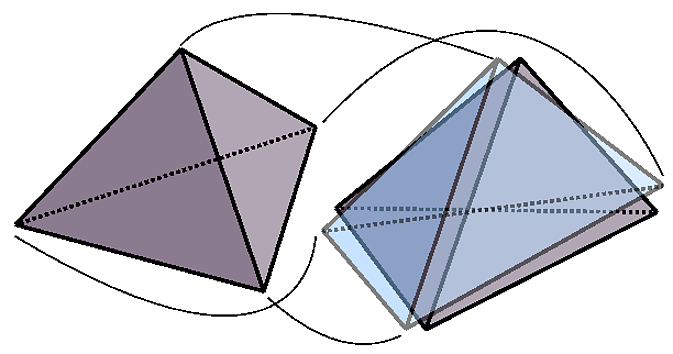My general premise is that I want to investigate the transformations between two distinct sets of vertices on n-dimensional manifolds and then find applications to theoretical physics by:
Minimalizing the change in the fundamental shape of the vertices (I want a convex polytope to stay a convex polytope).
Describing the dynamics of the transformation. (Possible applications to theoretical physics)
Finding constraint conditions on what can and cannot occur when the space in which the transformation is occurring is not "regular". This includes not-everywhere-differentiable manifolds, singularities, and other pathological cases.
Well, what an ambitious project. But in any case I have made some progress for the n-dimensional case with n-vertices where the space is "regular" and I haven't introduced advanced mathematics yet. I'm mostly playing around in configuration space for vertices in euclidean space or something similar.
I have defined a functional in configuration space that gives the length of all possible paths in configuration space between two distinct sets of vertices in $\mathbb{R^n}$ as follows:
$$T = \int\limits_{\lambda_{1}}^{\lambda_{2}} \sqrt{\sum_{I=1}^{n} \sum_{i=1}^{d} \left(\frac{d}{d\lambda}\left(\sum_{j=1}^{d} s(\lambda)R_{j}^{i}(\lambda)(q_{I}^{j}(\lambda) + a^{j}(\lambda))\right)\right)^2} d\lambda$$
Where $\lambda_{1}$ and $\lambda_{2}$ correspond to the start-point and end-point of the transformation. The members of the gauge group are $s$ (dilatation), $R$ (rotation), and $a$ (translation). $q_{I}^{j}$ corresponds to a point in configuration space representing $I$ vertices and it lives in $j$ dimensions. ($i$ is also a dimension index)
You can think of the equation as finding the straight line between two points (in configuration space) given all of the varied paths when you solve for constraint conditions in the Euler-Lagrange equation (recall): $$\frac{\partial{f}}{\partial{x}} - \frac{d}{d \lambda} \left(\frac{\partial{f}}{\partial{\dot{x}}}\right) = 0$$ This is represented in the figure below when the space has no curvature.

Hopefully, you have a general idea about what I'm talking about, this is at about page 5 in the paper where this is introduced, there is a lot of background that I'm not going to discuss. I've constructed an explicit example with tetrahedra where a tetrahedron is approximated to another tetrahedron in a minimalized manner. Here's a figure I made:
 that may help you understand what I'm trying to work with... in any case I'll ask my questions now.
that may help you understand what I'm trying to work with... in any case I'll ask my questions now.
-
[Optional for the intrigued reader]:
How can I begin to generalize this geodesic equation so that it can comment on spaces with different metrics, or irregular behaviour? As an example of what I am trying to reach for, I would be interested in seeing how a set of vertices could geodesically traverse a singularity in a smooth 2-manifold, and if I could define a general functional for any behaviour on any manifold (I would attempt to restrict it to 2-dimensions to start) eventually. There are two main types of singularities I would be interested in investigating, the first would be the "black hole type" in which a diffeomorphism in the manifold causes "a hole at the bottom". This means that there would be an exponential increase in curvature around the vicinity of the singularity, and I want to find out how a set of vertices deals with those imposed conditions. The other would be for a 2-manifold with no curvature and I know that for a particular configuration of vertices, with the geodesic (based on the equation above) lying along a certain line. If I create a hole (simply remove a point in the same way you can create a hole in a single-variable piecewise defined real function), what happens to the geodesic? How can I encode this information, so it either pushes right through the hole somehow, or defines a new path around it?
-
Main Question: For a functional (assuming I could derive one) that gives the path from a distinct set of vertices to another in an n-dimensional smooth manifold with shape preserving characteristics. When a singularity is introduced into the manifold, will the geodesic equation:
Somehow push through the singularity/ignore it is present.
Define an alternate path around the singularity (this is what I hope, so I can investigate further with applications to black hole dynamics)
Become undefined and nothing useful results
